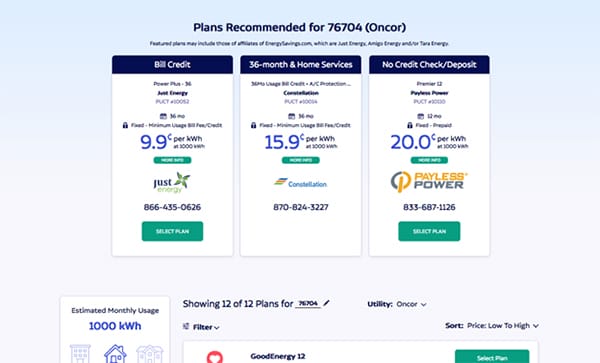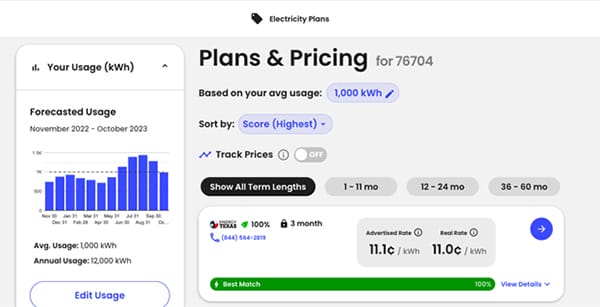
We here at EnergySavings.com are a price comparison website looking to help Texans and businesses lower their electric bills and improve their buildings’ energy efficiency.
We’re not alone with that aim in Texas’ deregulated energy market. Many price comparison websites are doing the same. But who is comparing those doing the comparing?
Our EnergySavings.com vs. EnergyBot guide weighs what these two companies offer, giving you, the consumer, the information you need to make informed choices about energy plans.
EnergySavings.com vs. EnergyBot: Switching Energy Suppliers
With monthly bills and energy costs rising, many people and businesses are reassessing their energy decisions. Some may feel they’re overpaying for their electricity usage.
Texas has a deregulated energy market, and approximately 85% of Lone Star State residents can shop around for electricity suppliers. Businesses are free to switch suppliers too in applicable service areas. Like any market, that means competition, and for those that can change significant savings may be available.
However, there are more than 140 retail electric providers (REPs) claiming they offer the best deals in Texas — that’s a lot of research for consumers. Price comparison websites help filter products and add an extra layer to any person or business owner looking for the best energy deal.
Note that the Public Utility Commission of Texas (PUC or PUCT) chooses the REP for anyone living or operating a business in a regulated service area in Texas.
EnergySavings.com vs. EnergyBot: Summary Company Information
This EnergySavings.com vs. EnergyBot guide will concentrate on Texas because that’s where EnergySavings.com operates. EnergyBot does cover other states and natural gas — we’ll detail those later.
Both companies are registered with the PUCT as official energy brokers, acting as intermediaries between consumers and electric companies. Here is their basic company information:
EnergySavings.com
- Part of Interactive Energy Group
- Headquartered in Plano, Texas
- Specializes in Texas-related electricity plans, energy news, and energy-efficiency tips
- Provides energy product information to citizens and businesses
- Over 20 years working in the Texas energy market
EnergyBot
- Headquartered in Dallas, Texas
- Also known As Blitz Ventures LLC
- Specializes in electricity and natural gas products to citizens and businesses across at least 15 states
- Operating since 2018
EnergySavings.com vs. EnergyBot: How Similar Are They?
EnergySavings.com and EnergyBot share many characteristics as price comparison competitors in the Texas energy market.
EnergySavings.com vs. EnergyBot: The Similarities
- Free-to-use price comparison websites acting as online energy marketplaces
- User-friendly search tools and filters find relevant energy products
- Highlight recommended products to browsers based on the information supplied
- Give people estimated monthly electricity bills based on their searches
- Official, registered energy brokers
- Share regular energy efficiency, renewable energy, and energy advice publications
- Help people decipher Texas’ deregulated energy market
- List Texas energy company details
Enter your ZIP Code and compare electricity rates
EnergySavings.com vs. EnergyBot: What’s the Difference?
There are many fundamental differences between EnergySavings.com and EnergyBot.
The most important is that EnergyBot’s central customer targets are businesses across many states. EnergyBot also advertises natural gas products, although not in Texas. EnergySavings.com, however, specializes in electricity for the state of Texas only.
Other differences include:
- EnergySavings.com focuses on electricity and energy issues for residents and businesses in Texas.
- EnergyBot advertises electricity in Texas, and electricity and natural gas products (where available) across many states.
- When switching suppliers, EnergySavings.com directs inquirers to deal directly with energy companies. Conversely, EnergyBot collects personal information to complete a deal.
- EnergySavings.com’s publications focus on Texas; EnergyBot takes a more nationwide approach.
- EnergySavings.com offers an energy-related newsletter.
- EnergySavings.com publishes contact information for utility companies in case of power outages and the PUCT.
- EnergyBot provides a lowest price guarantee (with conditions) and the chance to create an account.
- There’s an energy usage comparison tool on EnergyBot’s website to allow people to check how energy usage compares to others in the area.
- EnergyBot provides advice about solar panel installations and a solar incentives database. The company also has a national electricity price tracker, updated daily.
EnergySavings.com vs. EnergyBot: Which States Do They Serve?
Only Texas residents and businesses can utilize EnergySavings.com’s electricity expertise and advertised products.
EnergyBot is different from EnergySavings.com. EnergyBot’s focus is on business energy plans — electricity and natural gas — across all the deregulated markets in the United States. It does, however, also list residential electricity plans in Texas, the only state where it offers this service.
Deregulated markets where Energy Bot compares businesses’ electricity and natural gas products include Connecticut, Illinois, Delaware, Maine, Massachusetts, Maryland, New York, New Hampshire, New Jersey, Oregon, Ohio, Pennsylvania, Rhode Island, Virginia, and Washington, DC.
EnergySavings.com vs. EnergyBot: How Do They Make Money?
The EnergySavings.com vs. EnergyBot comparison agrees on at least one thing — both are energy brokers. That means they act as intermediaries between customers and energy companies and do not generate or sell energy.
Both price comparison sites are free-to-use services that earn money from the companies whose deals they publicize. Browsers clicking on links or signing up for energy deals can — but not always — help the two firms earn money through sales and marketing commissions.
EnergySavings.com and EnergyBot publish unbiased and accurate energy-related information, with advertisers not influencing editorial content.
Do EnergySavings.com and EnergyBot Review Energy Companies?
EnergyBot has an extensive list of dozens of energy companies that serve its service areas. There is more information for some than others — EnergyBot states it doesn’t work with every energy provider.
For example, EnergyBot doesn’t work with Amigo Energy but does list the company’s contact details, website, and ratings. Just Energy is another provider without links to EnergyBot yet has more information, including descriptions of its energy plans, payment options, and good causes it supports.
A quick look at EnergyBot’s APG&E energy page reveals a trove of information, including dozens of energy rates and links to specific plans like renewable energy-powered products. There’s a company summary, headquarters details, and much more.
EnerySavings.com has some energy plan, contact, and business information about a few energy companies, some of which are affiliates.
EnergySavings.com vs. EnergyBot: Which Has Lowest Prices?
It’s almost impossible to declare which company has the best rate or lowest prices; there are thousands of energy deals to consider, which change daily. Also, the best energy plan for someone is not always the one with the lowest price.
Interestingly, EnergyBot publicizes a like-for-like lowest-rate guarantee (online), albeit with conditions.
However, the most suitable energy plan is as individual as the person or business requesting the service. The lowest rate may not be the best energy plan. Here’s why.
Note: EnergySavings.com and EnergyBot can only be compared on Texas electricity plans because this is the only service overlap. We’ll focus on residential deals because businesses invariably require a bespoke energy package that involves contact with an energy expert.
Price Comparison Websites: What to Know Before Starting
Anyone switching suppliers should understand their utility bill before starting. The building blocks are energy usage, at what times, and at what current price.
Kilowatt-hours (kWh): Electricity deals are advertised in kWh. Check recent bills and know your monthly kWh usage and when.
Fixed-rate or variable-rate options: A fixed-rate kWh price stays the same for the entire contract length but may require a credit check, deposit, and carry an early termination fee. Variable-rate deals have varying rates set by market forces — often higher than fixed-rate options — but are usually flexible with no cancellation fees or credit checks.
Time-of-use: This is very important for residential and business customers. Energy companies may have special deals for people that use electricity mostly on the weekends or at night. Free nighttime energy may not be much use if you have the air conditioning on all day and go out every night, but it is if you charge an electric vehicle(s).
And consider if you want renewable energy to help reduce your carbon emissions.
What Is the Power to Choose Website?
Another good starting point to familiarize yourself with comparing energy prices is the PUCT’s official price comparison website, Power to Choose. This independent website presents information without recommended deals or sales tools to lure customers.
EnergySavings.com has many articles about how to use Power to Choose, while EnergyBot has its own guide. Price comparison websites tend to offer more user-friendly search systems than Power to Choose.
EnergySavings.com vs. EnergyBot: A Price Comparison
We searched for ZIP code 76704 (Waco) on Nov. 30, 2022, for 1,000 kWh monthly usage. Approximate per-month kWh usage figures are 500 (low), 1,000 (medium), and 2,000 (high).
Ensure you can reach minimum usage or time-of-use elements, or risk being charged a higher rate. Note that the results below can change without prior notice.
Remember: Neither EnergySavings.com nor EnergyBot generates power or provides electricity. They display information about electric company deals.
EnergySavings.com vs. EnergyBot: Using Their Search Tools
Firstly, EnergySavings.com’s and EnergyBot’s websites work in very different manners.
EnergySavings.com requires a ZIP code, and then users change filters to refine their search.
EnergyBot also requires a ZIP code and asks questions before displaying results. These are if it’s for a home or business, switching suppliers or a new service, your energy usage (including your actual meter readings), and contract length.
Somewhat confusingly, EnergyBot’s search tool doesn’t ask for kWh usage but for monthly energy bill amounts: from $0-150 (apartment), $150-300 (small home), and $300+ (large house). Its renewable energy section is also a little vague, asking how important renewables are to the customer. The importance ratings are labeled as “extremely renewable” (e.g., 100% renewable), “depending on the cost” — which means important for someone who doesn’t want to overpay, or simply “show me the lowest-priced plans,” regardless of their renewable energy element.
Finally, people can see the advertised or real rate; we found most of these rates to be the same, or 0.1 cents per kWh different at most.
Comparison of Rates: EnergySavings.com vs. EnergyBot
EnergySavings.com found the following for ZIP code 76704:
- Prices between 9.9 and 20 cents per kWh
- Contracts lasting six to 60 months
- Fixed-rate, minimum usage, and prepaid offers
- At least 15 different energy plans
EnergyBot found the following for ZIP code 76704:
- Prices between 12.8 and 25.4 cents per kWh
- Contracts lasting three to 48 months
- Fixed-rate, minimum usage, and prepaid offers
- Several dozen options
EnergySavings.com vs. EnergyBot: What the Energy Deals Mean
EnergySavings.com highlighted three deals based on the search, along with 12 other plans.
Filters include:
- Minimum usage
- kWh energy usage
- Renewable energy elements
- Time-of-use deals like free weekends
- Contract length
- Fixed-rate or variable-rate deals
- Choosing by the energy provider
There are also search filter tips for people moving homes or those switching suppliers.
The best energy rate came from Just Energy’s Power Plus 36 offer. This fixed-term deal lasts 36 months, costs 9.9 cents per kWh throughout, and would cost an estimated monthly bill of $99.
There is a minimum usage clause — fail to use 1,000 kWh for a month and the kWh price increases — but use more than 1,000 kWh per month and receive a $100 bill credit. There’s a $175 early termination fee, so this product suits someone who knows and monitors their energy usage and wants to lock down a low kWh price.
EnergyBot shows how well-matched its products are to your information in percentages (20-100% in our case), the energy provider and its telephone number, contract length, and the amount of renewable energy.
Clicking on “view details” reveals early termination fees and an anticipated average electricity bill. Filters include kWh usage (not the initial monthly bill value from earlier), estimated bills, rates, and review scores. Interested browsers can also subscribe to a price tracker for their search.
EnergyBot’s 100% match deal was a fixed-rate, three-month offer from Energy Texas, whose real rate of 11 cents per kWh was 0.1 cents cheaper than the advertised rate.
The product carries a $100 early termination fee and an estimated monthly bill of $110.39 per month, around 10% higher than EnergySavings.com’s best energy deal. This short-term deal may suit someone happy to switch suppliers regularly.
Both companies provide links to energy plans’ Electricity Facts Label (EFL) with contract details, the terms of service, and your rights as a consumer, as per Texas law.
Top tip: Always read every offer’s Electricity Facts Label (EFL) before signing any new energy deal. EFLs detail a contract’s terms and conditions.
EnergySavings.com vs. EnergyBot for Business Customers
Business energy supply is where these two price comparison websites differ significantly.
EnergySavings.com only offers electricity to companies in Texas and asks business owners to contact its energy experts to discuss bespoke energy solutions. Basic business details are requested, including contact details, current approximate utility bill cost, and ZIP code, before one of EnergySaving.com’s industry specialists gets in touch.
EnergyBot covers up to 16 states, offering businesses natural gas and electric plans. It has a ZIP code search tool similar to the Texas residential electricity model explained previously to show the basics before asking for company contact details. Alternatively, business owners can contact EnergyBot directly for a customized energy package.
How to Contact EnergySavings.com and EnergyBot
EnergySavings.com’s employees focus on publishing the best electricity rates in Texas alongside energy-saving tips. A customer support team will answer any queries sent to support@EnergySavings.com.
EnergyBot features a customer service email, an online contact form, and a telephone customer service option.
Both firms have Facebook, Twitter, LinkedIn, and Instagram presences necessary for sharing their energy-related publications.
EnergySavings.com vs. EnergyBot: Who Has the Best Blog?
Honesty, transparency, and editorial independence are both price comparison websites’ bottom lines.
EnergyBot’s website has many articles and resources covering everything from water heaters to tax credits on energy efficiency upgrades.
EnergySavings.com’s Texas residential energy expertise is seen through its regular blogs, energy news section, and Texas electricity price analyses. Blogs range from solar-powered outdoor LED lights to reducing energy consumption with programmable thermostats or learning how to use energy-hog power strips properly.
There are practical tips on ENERGY STAR-labeled appliances, including hot water heaters, clothes dryers, HVACs, and information on energy-efficient light bulbs.
EnergySavings.com vs. EnergyBot: In Conclusion
Energy use is a hot topic, and price comparison websites are an excellent way to learn more about saving money, energy, and carbon emissions.
EnergySavings.com and EnergyBot provide various supportive and informative articles to help people understand deregulated energy markets in Texas and across the United States. Once informed, their user-friendly search tools allow people to weigh up different energy products.
EnergySavings.com’s strong point is its 20 years of specializing in Texas’ residential electricity market. Its work focuses on this one aspect of the energy market, and its website visitors are directed to communicate directly with energy companies.
EnergyBot’s website targets helping businesses with their electricity and natural gas needs across the country. People can complete almost all switching or connection transactions on the EnergyBot website. Notably, it is a relative newcomer to the Lone Star State; Texas is the only state where EnergyBot offers residential electricity plans.
Price comparison websites help make life easier, and switching on a whim is tempting. Remember to always ask yourself these questions before switching electricity suppliers.





